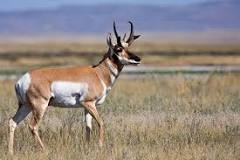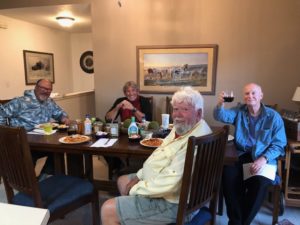Last month, five of us local anglers went on a 11-day fly-fishing trip for trout to the Yellowstone National Park in Wyoming. Our group was made up of Paul Knauth and Craig Smith of Hinsdale, Allen Gray of Pittsfield, Attorney Michael Shepard of Dalton and me.
We flew into Bozeman, MT, rented a vehicle and drove to Gardiner, MT, where we rented a nice house on the banks of Yellowstone River (Upper Yellowstone River Retreat, Relax@yellowstoneretreat.us) just a short distance from the entrance to the Park and each day, we traveled to our fishing destinations in it. Yellowstone National Park is 63 miles north to south, and 54 miles west to east as the crow flies. It encompasses 2,219,789 acres; 3,468 square miles and is larger than the states of Rhode Island or Delaware. The park sits on the Yellowstone Plateau, at an average elevation of 8,000 feet above sea level. The plateau is bounded on nearly all sides by mountain ranges of the Middle Rocky Mountains, which range from 9,000 to 11,000 feet in elevation.
While there, we did some sight-seeing of geysers such as Old Faithful and the Mammoth Hot Springs, watched elk munching on the lawns of the park headquarters (formerly Fort Yellowstone), watched the wildlife in the Lamar Valley, and were held breathless by the beauty of the area.
We carried canisters of bear spray wherever we fished, even if we fished the Yellowstone River in back of our house, for there had been recent reports of grizzly sightings there. If you have been following this column over the years, you know that for some reason bears (black and grizzly) have some kind of attraction to Mike Shepard and me and usually cause us some form of consternation. We did a lot of looking over our shoulders while fishing in Yellowstone.
One day, I was totally focused on fishing a particular stretch on the Soda-Butte Creek where I saw that there were some nice cutthroat trout feeding. In order to get to it, I had to cross one branch of the creek, walk across a small island and then fish the branch on the other side. I was totally focused on those trout. Then I thought I heard a sound behind me. It was kind of a low inhaled snort and it sounded quite close.
When I turned around, I was startled to be face-to-face with a HUGE bull buffalo and he was looking at and walking (not rushing) straight toward me. What do you do when a 10 foot, 2,000 lb buffalo approaches you? Why step aside, of course, and that’s what I did. He just walked by me toward the river. He was so close that I could have touched him with the tip of my flyrod. As he went by, he continued that deep, soft snort and I could almost understand him saying, “Darned fly fishermen, they’re everywhere these days. Get out of my way dude so I can cross this river”.
Every day while driving back and forth to the rivers in the park, and we fished several, we saw herds of buffalos (or bison if you prefer). The Yellowstone herd size is estimated to be ovcr 5,000. More times than not some would opt to step out onto the road and just stand there or slowly poke along the center line, holding up traffic and not leaving until they were ready to. They were everywhere, especially in the Lamar Valley and lots of people were parked off of the roads observing them and other animals with their high-powered sighting scopes and cameras.
If you go there to fish, you cannot use felt-soled boots, no lead, the flies must be barbless and the fish should be released. In order to gain access to the park, you must have a pass and a permit to fish in it.
When we returned to our house at the end of each day and sat out on the back deck having a drink, elk would show up on the lawn and eat the leaves off of (and nearly destroy) a young apple tree as well as the green grass that was watered daily via a pump from the river. They showed up nearly every day, sometimes not more that 15-20 feet away from us. There was also a bull elk there keeping his group of cow elk in line.
One day, a buck antelope (pictured) appeared on the other side of Slough Creek from where we were fishing. We had all gathered there at the end of the day before our long trek back to the vehicles. He seemed agitated that we were there and jumped into the river and swam toward us. Climbing out of the creek, he was ready to do battle with us, kicking up dirt with his hoof and his head down.  He especially wanted to do battle with Paul and starting approaching him. We told Paul to be careful as those antlers are sharp. But Paul stood his ground, threw his hat down, kicked up a little dirt of his own and shouted “C’mon, let’s see what you got!” The antelope chickened out and walked away.
He especially wanted to do battle with Paul and starting approaching him. We told Paul to be careful as those antlers are sharp. But Paul stood his ground, threw his hat down, kicked up a little dirt of his own and shouted “C’mon, let’s see what you got!” The antelope chickened out and walked away.
Yellowstone National Park is filled with all kinds of animals. In addition to the elk, buffalo and antelope, we saw a family of moose, a black wolf with its pups, golden and bald eagles, ospreys, a black bear, sand hill cranes, otters and more. Thankfully we saw no grizzlies or cougars although they do exist there. The scenery is breath-taking.
None of us are exactly spring chickens. Three of us are in our 70’s, a 65 year older and a kid aged 56. Unfortunately, I had the dubious distinction of being the oldest. Our bodies, although having been dinged over the years and sporting some replacement parts, still carried us for miles through the prairies, ever on the alert for gopher holes, to get to good looking fishing spots.
We ate well on this trip with Mike and Allen doing the cooking. After dinner, we gabbed around the dinner table, had a night cap and hit the sack. We didn’t have any television service and quite frankly, we didn’t miss the shenanigans going on in Washington these days.
The weather was unpredictable with 90-degree sunny weather one day and biting cold wind and rain the next. The fishing was just as unpredictable with some days getting skunked or only catching a couple of fish and on other days we had great catches.
So how did we do? So many people have written that fishing is not all about fishing. The most recent words that I read regarding this subject were by Cameron Pierce in the introduction to his new book, Taut Lines. “ …but as all anglers know, the fish themselves are only half of fishing. Finding peace, spirituality or a sense of belonging in nature, the meditative tranquility that settles in the mind and body as you cast into the waters for hours on end, the companionship or, alternately, the solitude; these are some of the things that hook anglers as much as fish”.
How true. Trout live in some of the most beautiful places in the world, surrounded by undisturbed, wonderful sights. Add to that the comradery of the anglers and you have the makings of a wonderful fishing trip whether you catch a fish or not. I tried to convey some of that feeling in today’s column.
Oh yes, by the way, we all caught big, lovely fish. Next week, I’ll tell you all about them.
Local trout stockings
The following local waters were scheduled to be stocked last week: Deerfield River, Littleville Reservoir, Goose Pond, Laurel Lake, Lake Buel, Onota Lake, Richmond Pond and Stockbridge Bowl.
Trout Unlimited Meeting
The Taconic Chapter Annual Meeting will be held at The Cork and Hearth Restaurant, Rt 20 Lee, MA on Thursday, October 10 at 6:00 pm. The guest speaker will be well known Fly Fisher/Fly Tier/Guide Torrey Collins. He will be discussing Great Lakes Salmon/Steelhead fishing. It is free and open to the public and if you wish, you can join them downstairs in the dining room for dinner after the event.
Berkshire Outdoorsman
Hunting and fishing in the Berkshires, MA
